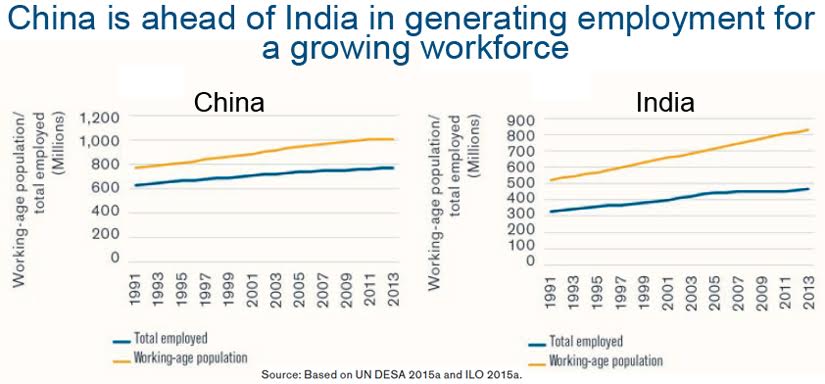Union finance minister Arun Jaitley now exercises more caution when he speaks about India’s economic performance during foreign trips. The ‘we-are-the-best-and-everything-is-fine-here’ tone has changed to the we-are-better-than-others-but-have-issues-to-sort-out tone, a more real and mature one.
At Washington, where he is leading a high-power Indian delegation to the annual fall meeting of the International Monetary Fund and the World Bank, Jaitley said,”More than even before we are at the centre stage. That you would have to admit. But, I would put a caveat. India has become far more aspirational than ever before. So compared to the rest of the world, we are doing much better. Compared to our own yardstick, we feel, this is not enough.”
 “We can do still better, which in a sense is not a bad thing to happen. To be restless, to be impatient is a sign of wanting to do better.”
“We can do still better, which in a sense is not a bad thing to happen. To be restless, to be impatient is a sign of wanting to do better.”
Indeed there is a buzz around India internationally.
With the projected 7.6 percent annual GDP growth in the next two years, India is the fastest growing major economy in the world.
Benefitting from oil price crash and internal adjustments, the government’s finances are in a much better shape now, consumer inflation is lower than what it used to be three years back (thanks to a vigilant RBI) and on the reforms front, after a long period of inaction, things are looking up (Credit certainly goes to PM Narendra Modi and team).
The government, which came to power with a landslide majority in the 2014 general elections, has indeed reversed the pessimistic mood in the economy prevailed during the UPA days. Structural reforms, with respect to indirect taxation and financial sector, subsidy reforms and efforts to revive industries, offer hope for a change on the ground.
But, what is disturbing to note is the trend in unemployment.
This is an area about which the Modi government typically talks less, and painfully so. According to various estimates, about 10 lakhs young citizens are entering the country’s job market every month. That’s 1.2 crore every year. It’s a huge number. Modi doesn’t seem to have a plan to how to face this young crowd.

A reccent PTI report, which cited a survey by Labour Bureau, said country’s unemployment rate has shot up to a 5-year high of 5 percent in 2015-16. This figure is significantly higher, at 8.7 percent, for women as compared to 4.3 percent for men. About 77 percent of Indian households do not have regular wage/salaried person.
Here, one needs to look at the previous years’ numbers to understand how serious is the 2015-16 figure. India’s unemployment rate was 4.9 percent in 2013-14, 4.7 percent in 2012-13), 3.8 percent in 2011-12 and 9.3 percent in 2009-10. There was no report from Labour Bureau in 2014-15.
And the situation is not looking better going ahead.
A World Bank research has showed that automation threatens 69 percent of the jobs in India. With the use of more technology, the pattern of traditional economic path in developing countries could be fundamentally disrupted, the report noted.
That’s not all.
Asia-Pacific Human Development Report released by the United Nations Development Programme (UNDP) this year gives a strong warning on the level of unemployment in the country. According to the report between 1991 and 2013 India could provide employment only to less than half of the new entrants into the job market. “The the size of the working-age population increased by 300 million (during the period), while the number of employed people increased by only 140 million — the economy absorbed less than half the new entrants into the labour market. A wider gap in India than China suggests a more limited capacity to generate employment — a serious challenge given the continued expansion of the workforce in India over the next 35 years,” the report said.
The increasing unemployment rate, as seen in the above mentioned numbers, thus raises questions on the quality of GDP growth India, Modi and his ministers often talk about. This has been the case in the recent years.
Why such high rate of joblessness? Lack of private investments to set up new factories and small-scale companies could be one reason. Increasing mechanisation and companies focusing more on higher efficiency as a measure to increase output, without hiring new staff, could be second. India’s archaic labour laws could be acting as a major turn off for the employers to hire new staff could be the third.
One thing is evident. Much of the GDP growth India has seen has come from consumption, rather than fresh private investments. This takes away the sheen from the GDP growth. That a jobless economic growth doesn’t really contribute to the country’s prosperity is something most economists agree. The big question before the government therefore is does it have a plan to accommodate the younger workforce? The efficacy of various initiatives launched by the Modi government since 2014, to name a few, Make in India, Start Up India, Skill India, needs to be introspected. Have these schemes begun to contribute to job creation in a significant way? If not, why?
The current scenario of unemployment cannot sustain.
India is one of the best sources of quality human resources to the world. Higher education isn’t scarce, jobs are. Lakhs of engineers, doctors and other professionals who flow in need to be accommodated in the workforce. The overburdened public sector system certainly cannot solely absorb the new work force. The private sector needs to play a major role.
The short point here is that all these figures tell us why the hoopla over the 7.6 percent growth figure and the status of world’s fastest growing economy status makes not much sense to most of India’s 125 crore people, who are the aspiring middle class, migrating to urban centres from India’s villages hoping better jobs and income.
Till the time higher growth doesn’t translate into higher number of jobs and better income for the aspiring middle class, China-beating economic growth or India being the centre-stage of the world are merely feel-good ideas on the paper for majority of India’s aam aadmi. This can eventually lead to unrest and negative sentiments. A jobless economic growth could thus, potentially, spoil Narendra Modi’s dream run in 2019.


